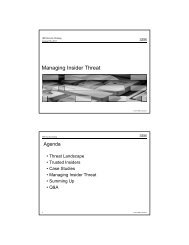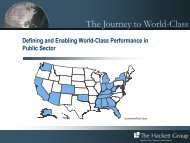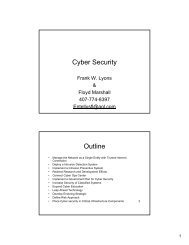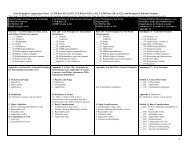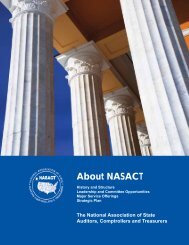The Appropriate Role Of The Internal Revenue Service With Respect To <strong>Tax</strong>-<strong>Exempt</strong> Organizati<strong>on</strong> Good Governance Issuesresp<strong>on</strong>sibility <strong>and</strong> accountability by n<strong>on</strong>profit boards that good governance entails in aworld of innumerable <strong>and</strong> unpredictable challenges.Some of the indicators that have become proxies for good governance c<strong>on</strong>cern thecompositi<strong>on</strong> <strong>and</strong> structure of n<strong>on</strong>profit boards <strong>and</strong> their committees, while others focus<strong>on</strong> board <strong>and</strong> committee resp<strong>on</strong>sibilities <strong>and</strong> operati<strong>on</strong>s. 35 The factors, varying withsource, can include: board size (focusing both <strong>on</strong> boards that are too small to provideproper oversight 36 <strong>and</strong> too large for meaningful participati<strong>on</strong>); qualificati<strong>on</strong>s of directors,including their independence <strong>and</strong> whether they collectively bring the requisite talents<strong>and</strong> resources; written expectati<strong>on</strong>s for directors, including board <strong>and</strong> committeeattendance requirements; agenda setting; executive board <strong>and</strong> committee sessi<strong>on</strong>s;board <strong>and</strong> committee orientati<strong>on</strong> <strong>and</strong> c<strong>on</strong>tinuing educati<strong>on</strong> programs; board committeeoversight of finance, audit, investment management, legal compliance, compensati<strong>on</strong><strong>and</strong> governance, <strong>and</strong> whether committees operate pursuant to written charters thatdelineate roles <strong>and</strong> resp<strong>on</strong>sibilities; 37 l<strong>on</strong>g-range strategic planning, with attenti<strong>on</strong> tomissi<strong>on</strong> statements, community or c<strong>on</strong>stituent needs assessments, <strong>and</strong> performancemetrics; periodic performance assessment of the organizati<strong>on</strong>, board, <strong>and</strong> individualdirectors; evaluati<strong>on</strong> of CEO <strong>and</strong> determinati<strong>on</strong> of CEO compensati<strong>on</strong>; approval of otherexecutive compensati<strong>on</strong>; successi<strong>on</strong> planning relating to the board <strong>and</strong> its leadership,as well as the CEO <strong>and</strong> key senior managers; selecti<strong>on</strong> <strong>and</strong> oversight of outsideauditors, auditor independence, <strong>and</strong> lead auditor rotati<strong>on</strong>; supervisi<strong>on</strong> of internal auditprocesses; oversight of financial c<strong>on</strong>trols; setting parameters for acceptable investmentallocati<strong>on</strong>s <strong>and</strong> practices; development <strong>and</strong> implementati<strong>on</strong> of various policies, includingc<strong>on</strong>flict of interest policies, whistleblower policies, document retenti<strong>on</strong> <strong>and</strong> destructi<strong>on</strong>policies, fundraising <strong>and</strong> gift acceptance policies, <strong>and</strong> codes of ethics; <strong>and</strong> practicesdesigned to promote transparency, including making publicly <strong>and</strong> readily available (suchas by posting <strong>on</strong> the organizati<strong>on</strong>’s website) an annual report, informati<strong>on</strong> aboutactivities, finances, structure <strong>and</strong> principals (officers, directors <strong>and</strong> senior managers),<strong>and</strong> disclosure of committee charters, policies, <strong>and</strong> documents reflecting governancepractices.Most of these proxies for a well-governed organizati<strong>on</strong> are not even indirectly rooted instate statutory obligati<strong>on</strong>s, let al<strong>on</strong>e in the Internal Revenue Code, but rather derive atbest imprecisely from the duties of care <strong>and</strong> loyalty. While this collecti<strong>on</strong> of indicators,to a greater or lesser degree, may all appear to be reas<strong>on</strong>ably related to the prudent<strong>and</strong> purposeful c<strong>on</strong>duct of the affairs of n<strong>on</strong>profit boards, as discussed immediately35No list intending to encompass every practice signifying superior governance can be complete, inasmuch as st<strong>and</strong>ards for goodgovernance evolve with the n<strong>on</strong>profit sector. See, e.g., the 33 st<strong>and</strong>ards set forth in the Panel’s Principles, supra note 13. Althoughresp<strong>on</strong>sibility for governance is typically discussed as a board functi<strong>on</strong>, many of the behaviors associated with superior governanceare, in fact, management functi<strong>on</strong>s; ultimate resp<strong>on</strong>sibility for ensuring implementati<strong>on</strong> of those behaviors, however, rests with theboard. See, e.g., ALI Draft N<strong>on</strong>profit Principles, supra note 17, § 320 (Board Resp<strong>on</strong>sibilities, Functi<strong>on</strong>s <strong>and</strong> Compositi<strong>on</strong>).36Some state laws provide for a minimum number of directors, (see, e.g., New York Not-for-Profit Corporati<strong>on</strong> Law § 702), whileothers set no minimum (see, e.g., Delaware General Corporati<strong>on</strong> Law § 141(b)). State laws may impose other requirements foreligibility for board service, such as a minimum number of directors who are independent of family ties. See, e.g., New HampshireVoluntary Corporati<strong>on</strong>s <strong>and</strong> Associati<strong>on</strong>s § 292:6-a (“In the interests of encouraging diversity of discussi<strong>on</strong>, c<strong>on</strong>necti<strong>on</strong> with thepublic, <strong>and</strong> public c<strong>on</strong>fidence, the board of directors of a charitable n<strong>on</strong>profit corporati<strong>on</strong> shall have at least 5 voting members, whoare not of the same immediate family or related by blood or marriage.”).37See, e.g., ALI Draft N<strong>on</strong>profit Principles, supra note 17, § 325 (<str<strong>on</strong>g>Committee</str<strong>on</strong>g>s <strong>and</strong> Delegati<strong>on</strong>).ADVISORY COMMITTEE ON TAX EXEMPT AND GOVERNMENT ENTITIES (<strong>ACT</strong>) June 11, 2008 14
The Appropriate Role Of The Internal Revenue Service With Respect To <strong>Tax</strong>-<strong>Exempt</strong> Organizati<strong>on</strong> Good Governance Issuesbelow, the empirical evidence to date does not c<strong>on</strong>firm the efficacy of specific n<strong>on</strong>profitgovernance practices, much less compliance with the requirements for maintaining taxexempti<strong>on</strong>. Under the circumstances, we must remain mindful that many of theseindicators of good governance are articles of faith <strong>and</strong> resist clinging to them withtalismanic certainty. While we do not mean to suggest that the adopti<strong>on</strong> of specificpractices <strong>and</strong> policies are not useful for many organizati<strong>on</strong>s in providing a structure thatassists them in their decisi<strong>on</strong>-making <strong>and</strong> operati<strong>on</strong>al processes, humility necessitatesthat we respect the diverse <strong>and</strong> evolving nature of the n<strong>on</strong>profit sector <strong>and</strong> c<strong>on</strong>tinue tovalue flexibility in our expectati<strong>on</strong>s of the specific governance practices that may beessential to the health of the sector. Thus, we support the aut<strong>on</strong>omy of anorganizati<strong>on</strong>’s governing body <strong>and</strong> its exercise of its business judgment as to what bestreflects the needs of its organizati<strong>on</strong>.C. What Empirical Evidence Exists About Governance?There is little or no empirical evidence with respect to n<strong>on</strong>profit governance. 38 In 2007,the Urban Institute released what it described as “the first nati<strong>on</strong>al representative studyof n<strong>on</strong>profit governance.” 39 That study, based <strong>on</strong> “self-reports” from the over 5,000n<strong>on</strong>profits that resp<strong>on</strong>ded to a survey, looked principally at six Sarbanes-Oxley inspiredindicators—external audits, independent audit committees, rotating audit firms/partners,c<strong>on</strong>flict of interest policies, whistleblower policies, <strong>and</strong> document retenti<strong>on</strong> policies—<strong>and</strong>then at factors (such as board size, board compositi<strong>on</strong>, organizati<strong>on</strong> size, field, <strong>and</strong>funding source) to determine which factors were associated with those indicators. Italso looked at specific self-reported practices, including the frequency <strong>and</strong>c<strong>on</strong>sequences of financial transacti<strong>on</strong>s between organizati<strong>on</strong>s <strong>and</strong> their boardmembers, board compensati<strong>on</strong>, levels of board activity in different roles, <strong>and</strong> thecorrelati<strong>on</strong> between various factors <strong>and</strong> that activity, <strong>and</strong> board compositi<strong>on</strong>. Thestudy’s design, however, allows for <strong>on</strong>ly nominal analysis as to whether the six SOXtypepractices are effective.There are, however, a number of studies involving for-profit corporate practices. Thequesti<strong>on</strong> then is what can the n<strong>on</strong>profit sector learn from for-profit corporategovernance? Corporate governance “best practices” in the n<strong>on</strong>profit sector haveborrowed heavily from the for-profit world. The history of regulati<strong>on</strong> <strong>and</strong> the pressure forgreater self-regulati<strong>on</strong> in both sectors have ebbed <strong>and</strong> flowed, emerging most str<strong>on</strong>glyin the face of public indignati<strong>on</strong> over abuses <strong>and</strong> crises, real or perceived, <strong>and</strong> thebelief—or at least hope—that imposing additi<strong>on</strong>al “safeguards” can forestall similar38When asked which governance practices have been empirically established to be effective during an interview for this report,Mari<strong>on</strong> R. Frem<strong>on</strong>t Smith, Senior Research Fellow <strong>and</strong> Adjunct Lecturer at the Hauser Center for N<strong>on</strong>profit Organizati<strong>on</strong>s atHarvard University, observed: “We have anecdotes of what fails, but no evidence of what works.” Interview with Mari<strong>on</strong> Frem<strong>on</strong>tSmith, September 27, 2007. See also Evelyn Brody, The Board of N<strong>on</strong>profit Organizati<strong>on</strong>s: Puzzling Through the Gaps BetweenLaw <strong>and</strong> Practice, 76 Fordham L. Rev. 521, particularly note 81 (2007).39Francie Ostrower, N<strong>on</strong>profit Governance in the United States (The Urban Institute 2007) (hereinafter 2007 Urban Institute Study”),at 21. There are organizati<strong>on</strong>s that survey n<strong>on</strong>profit organizati<strong>on</strong>s from time to time about their governance practices. See, e.g.,The 2007 Grant Thornt<strong>on</strong> LLP Nati<strong>on</strong>al Board Governance Survey for Not-for-Profit Organizati<strong>on</strong>s.ADVISORY COMMITTEE ON TAX EXEMPT AND GOVERNMENT ENTITIES (<strong>ACT</strong>) June 11, 2008 15






